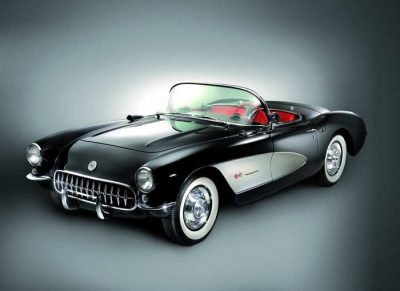SCM Analysis
Detailing
| Vehicle: | 1957 Chevrolet Corvette Fuelie |
| Number Produced: | 64,375, 7,828 FI cars |
| Distributor Caps: | $19 |
| Engine Number Location: | Top left surface of flange on rear of block |
| Club Info: | Corvette Club of America, P.O. Box 9879, Bowling Green, KY 42102-9879 |
| Website: | http://www.corvetteclubofamerica.com |
| Alternatives: | 1956 Austin-Healey 100-Six; 1957 Ford Thunderbird F-code; 1958 Arnolt-Bristol DeLuxe |
| Investment Grade: | B |
This 1957 Chevrolet Corvette Fuelie Convertible sold for $132,000 at RM’s Monterey sale, held August 19-20, 2005.
A ’57 Fuelie ‘Vette is one of the hallmark cars of the 1950s, the work of Harley Earl, one of the most important automotive stylists of all time. The designs he spearheaded during this era had tremendous impact on our culture-and this Corvette is one of his finest.
Its toothy chrome grille, wrap-around windshield, space-age interior, wonderfully sculptured round tail with twin exhaust pipes exiting out of the rear bumperettes, and those signature scalloped side coves are all wild elements, yet they come together perfectly. Subtle it is not, especially when the cars are finished in contrasting colors and with an equally bright interior. When I was a boy, that’s exactly why I chose the ’57 Fuelie as my favorite ‘Vette.
I dreamed of some day owning one, but that childhood desire remained both dormant and unfulfilled until the early 1990s, when I was afforded the opportunity to drive a ’57. I was working for Christie’s at the time and the car was consigned to our Pebble Beach sale. It was a Bloomington Gold winner, meaning that it had been judged to be nearly perfect in its restoration, the best of the best.
The Corvette Fuelie Convertible had been unloaded by its transporter at the top gate of the 17-Mile Drive entrance to the Lodge. Someone had to drive it down the beautiful, tree-lined road that wound around to the auction tent, so I eagerly hopped in, warmed it up, and off I went. But as I gained just a little speed things went awry.
This twisty section of road was part of the famed course that had once been the site of the treacherous Pebble Beach Road Race. I realized rather quickly that my steed was not really up to the task, and as I struggled to keep the Corvette on the road, I felt like I was sitting on my living room couch and someone had pushed me over the crest of the Laguna Seca Corkscrew.
It was an exciting ride, to say the least. As I headed vigorously into a tree-lined left-hander, I prayed I’d be able to get the four screeching tires around the turn. The extreme amounts of body roll and lethargic steering, however, also had me wondering for a few split seconds if indeed the chassis and body had become detached.
Thankfully, I arrived at the tent in one piece. More importantly, so did the car.
While blame for such typical ‘Vette behavior is usually cast on Zora Duntov and GM, responsibility for the many unflattering words I shouted while heading down that hill would more accurately be levelled at this car’s old bias-ply tires and unsorted brakes and suspension. This is a common affliction of even “perfectly” restored cars. Just because a car exhibits the highest cosmetic finish does not mean it is capable of performing as capably as it did when new.
Corvettes of the ’50s have a broad appeal and a devoted following. Their sensational styling, strong reliability, and wealth of spares make them fun and reasonably secure investments. Anyone thinking about playing with ‘Vettes, however, would do well to start by picking up a copy of Mike Antonick’s Corvette Black Book. It contains enough information about vehicle numbers, engine numbers, and option codes to convince you to seek help from an expert before you raise your hand at auction.
Corvettes are among the most well documented collector cars out there, so making a mistake with regards to things like “numbers-matching” claims or certification by organizations like Bloomington Gold and the National Corvette Restorers Society could cost you tens of thousands of dollars.
So, too, can not knowing the history of the car you’re bidding on. The Corvette Fuelie Convertible pictured here sold for $100,440 at Barrett-Jackson Scottsdale in 2004. At the time, it was rated a #2+ by the SCM auction reporter and described as “an excellent restoration that has seen some over-the-road usage.” The car then appeared at Silver’s 2004 Hot August Nights sale in Reno, where it was bid to $59,000 without selling.
Fast-forward to RM Monterey a year later, where the car sells for $132k-very strong money, especially considering those last two trips across the block.
An astute bidder is going to have a lot of questions about a car like this, starting with why it’s been offered for sale so many times in the past year and a half. Just as people assume the house that’s been on the market for months must have something wrong with it, frequent auction appearances do not usually result in a bump to a car’s value.
Documentation of the “18 miles since completion of a no-expense-spared, body-off restoration” claim, however, would. Assuming the bidder did his homework, and that the Corvette Fuelie Convertible is both authentic and well sorted out, I would call this price top-of-the-market, but not crazy.
